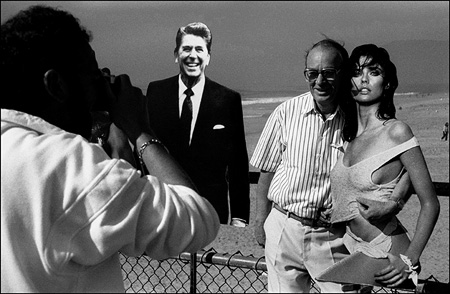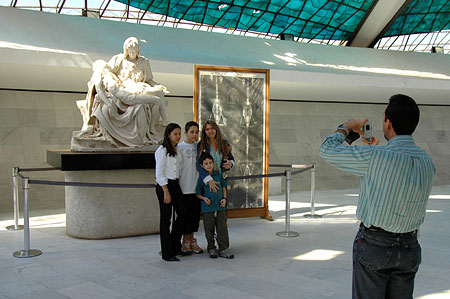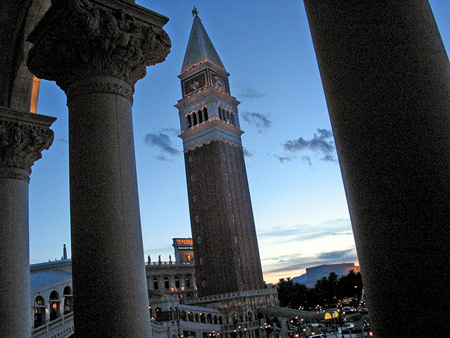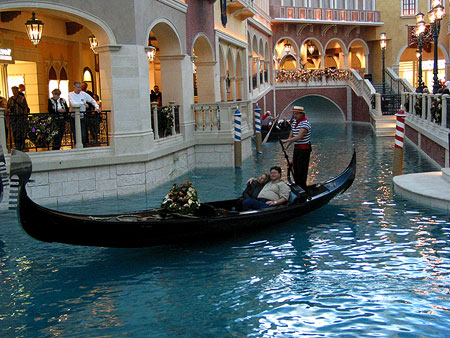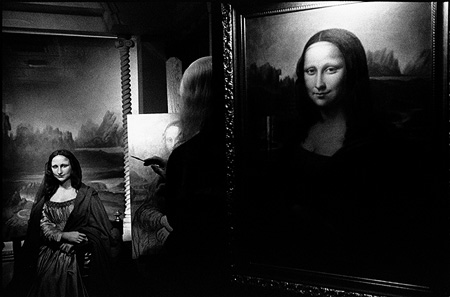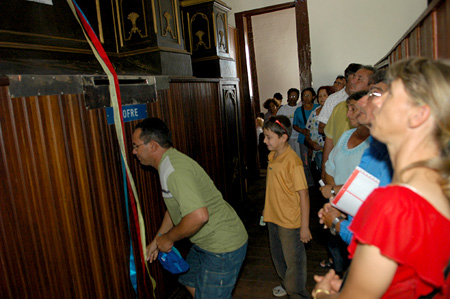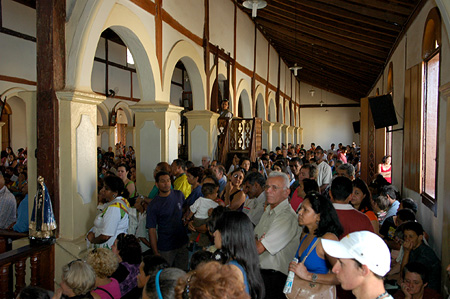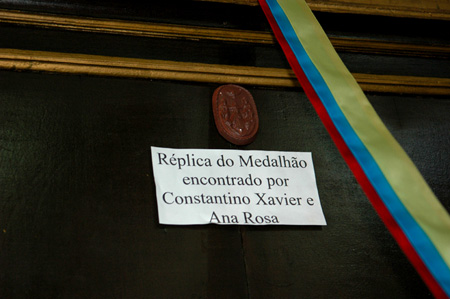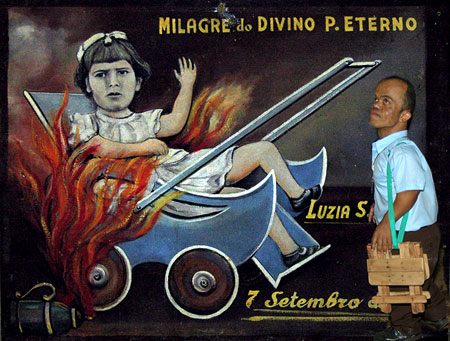"What was that about originals?"
***
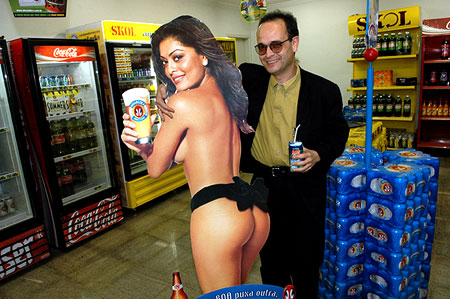 |
Brasilia, Brazil © Pedro Meyer, 2004
|
|
My friend Juan Alberto Gaviria, from Colombia, and I, were in Brazil recently, and at a local gas station store I came upon the image of one of Brazils’ super models promoting a brand of beer. It reminded me to another image I had taken 16 years ago in Los Angeles, of one more cardboard cut out with then President Reagan looking on. It intrigued me already then, how the representation of a cardboard woman had such a strong visual impact on the viewer or on the person that was being photographed with the model in their proximity. Juan Alberto, ever the gentleman he is, was proving to be enormously tender, almost not touching the model, even though the image was nothing other than cardboard. In contrast to the strong hug given to the girl by the man in the earlier picture, in either instance, we are of course just looking at surrogate realities.
Cardboard, Malibu, California © Pedro Meyer, 1988 This form of projecting ourselves onto images is very much what happens in the cinema, were our subjective self is intermingled with the images seen on the screen. We feel like hugging the actress of our dreams in much the same way. I might add, as an aside, that the intervening years between the two images brought forth a new element to such work, namely the use of color. Something that was made possible for those of us who started to work with digital cameras. Before, when I used film, it was only black and white that I could afford to produce work in. Today, most of my colleagues who used to work in black and white, and who have now used digital cameras, have also moved from b&w representations to color. But going back to the issue of representation, let us take a look at the picture taken in the Cathedral in Brasilia, which I visited recently, you will find they have there a reproduction of the Pieta by Michael Angelo in Rome, and the Holy Shroud of Turin. The latter one is a framed enlargement of an X-ray image (already a further level of abstraction), and what do people do there? They take pictures of themselves in front of such representations. For them apparently there is no difference or need to differentiate between the original and such reproductions. Come to think of it, there is not that much of a difference for all those who go to Las Vegas and have their images taken in front of every sort of representation that one can find there.
Cathedral in Brasilia, Brazil © Pedro Meyer, 2004 What’s more, many of the reproductions that one can find in Las Vegas, are not even the reproduction of an “original” but that of yet another reproduction, which only through the patina of time, became itself an “original”. That being the case for instance, with the Campanile in the Main Piazza de San Marcos in Venice, which was itself, a reconstruction as we are told. Therefore the tower at the Venetian Hotel in Las Vegas is a reconstruction of the reconstruction that is in Venice. There is no original. (see http://europeforvisitors.com/venice/articles/campanile_di_san_marco.htm)
The Venetian, Las Vegas © Pedro Meyer, 2001 And then you can find that the canals of Venice reproduced in Las Vegas, happen to be flowing as you stand on the fourth floor of a building, with fake facades all along the sides, and every one quite content as they hear fake gondoliers sing out in what could be said are well intentioned versions of Italian interpretations but certainly no real Italian.
The Venetian, Las Vegas © Pedro Meyer, 2001 But what is the difference, when President Bush makes a trip to visit the US troops in Iraq for Thanksgiving, and does so only to pose with a fake Turkey for a fake dinner which he never really attended, as he flew in and out as fast as he could (we are told for security reasons). Or the faked landing earlier on the aircraft carrier, dressed up in a pilots suit in order to say “Mission Accomplished”. People want to believe their president and therefore suspend any critical judgment in spite of the blatant deception that is behind all these actions. Going back once again to an earlier decade, as I was traveling in California, I came across this wax museum, which featured a three dimensional wax reproduction of the Mona Lisa being painted by Leonardo Da Vinci, and in order to give credibility to such images, they of course presented the public with a reproduction of, what else? the painting of the Mona Lisa that hangs in the Louvre in Paris. It was thus that a reproduction lent credibility to yet another reproduction, and all of this recorded by a photograph, which was a reproduction itself with the additional abstraction of being in black and white.
Mona Lisa in the Wax Museum, San Francisco, California © Pedro Meyer, 1986 Thousands of people were lined up to pass in front of an altar, one by one, with a clearly marked signed that what was their object of veneration was in fact a replica. Notwithstanding, the multitude that had come from the entire region, which might easily have been three hundred thousand strong, and gathered in the city of Trindade in the State of Goias in Brazil, found no problem in bringing their devotion and money to the coffers of the church which was being very forthright in telling their devotees that what they had to venerate was a reproduction. All these good people had come for their annual “Romeria Do Divino Pai Eterno” which is celebrated on the first Sunday of July of each year.
Trindade, Brazil © Pedro Meyer, 2004
Trindade, Brazil © Pedro Meyer, 2004
Trindade, Brazil © Pedro Meyer, 2004 We are left with the idea to question the moralistic approach that so many photographers have taken towards the representation of the image in these digital times, in so far as pictures “telling the truth”. As what is the truth that is in fact being told through images? Trindade, Brazil © Pedro Meyer, 2004 We believe it is helpful to take a look at how the world actually likes to see itself represented. And how far human nature is capable of bridging one’s own reality with that of the multitude of representations that have nothing to do with being “honest”. There probably isn’t a single “official” picture of a celebrity or movie star, that is not doctored to make the person appear according to some fantasy of what he or she would like to look like. For issues related to faith there is no possible evidence that is more real than the desire of the belief. Be that in terms of religious practices or in other aspects of daily living. The stuff dreams and desires are made out off; breach all possible factual evidence that could run contrary to such intentions. How else can one explain the worldwide complacency to deal with surrogate realities as if they were originals? Take for instance this religious Jew who with his cell phone in hand is bringing someone's prayers to be "heard" by the Wailing Wall, otherwise known as the Western Wall in Jerusalem, in something of a surrogate reality leap of major proportions. The need to be in front of the "original" wall, apparently is no longer a requisite.
by courtesy of the Agence France Press. When I first exhibited this image of the chair standing there on a pedestal in the street, everyone who saw it was of course convinced that I had placed the chair there using Photoshop. The possibility that this would be a real chair was of course dismissed right away. The more plausible explanation of a digital manipulation made more sense than the extravagant idea that in Washington, DC, there is in fact such a chair. The notion of the real and and the fake had come full circle. We now tend to dismiss the real because it looks like a fake. Monumental Chair, Washington, D.C. © Pedro Meyer, 1989 The “truth” is that in their own way, when all is said and done, all fakes and surrogates also become their own sort of original.
Pedro Meyer Please share your comments on this issue with us in our forums.
|
|

